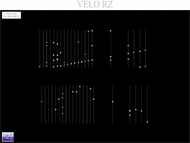Computer images of the first beam through beam through LHCb (see video on YouTube or CERN CDS)
The LHC’s anti-clockwise beam transfer system was tested over the weekend June 6-7, 2009. Particle bunches were sent from the SPS through the transfer line towards the LHC where it intersects just before the LHCb cavern.
The beam was sent down the 2.8 km transfer line and stopped just before reaching the LHC tunnel with a ‘beam stopper’ (known as a TED) – 4 m of graphite that is physically placed in the path of the beam line to prevent the beam from taking the last step into the LHC.
Part of the LHCb detector was turned on during the beam test, and the teams managed to catch a glimpse of the secondary particles produced when the beam hits the ‘beam stopper’.
The picture shows the tracks reconstructed by the LHCb Vertex Locator (VELO). The particles passed through the LHCb detector in the reverse direction, i.e. passing first through the muon stations and then emerging through the VELO detector.

Events (see here) observed in the two halves of the Vertex Locator VELO during this test. The vertical lines show the position of the VELO modules with points showing particle impact distance from the LHC beam line multiplied by 8. Yellow lines show the reconstructed particle trajectories. Particles were moving on straight lines, the observed track curvature is the effect of projection on the display plane.
